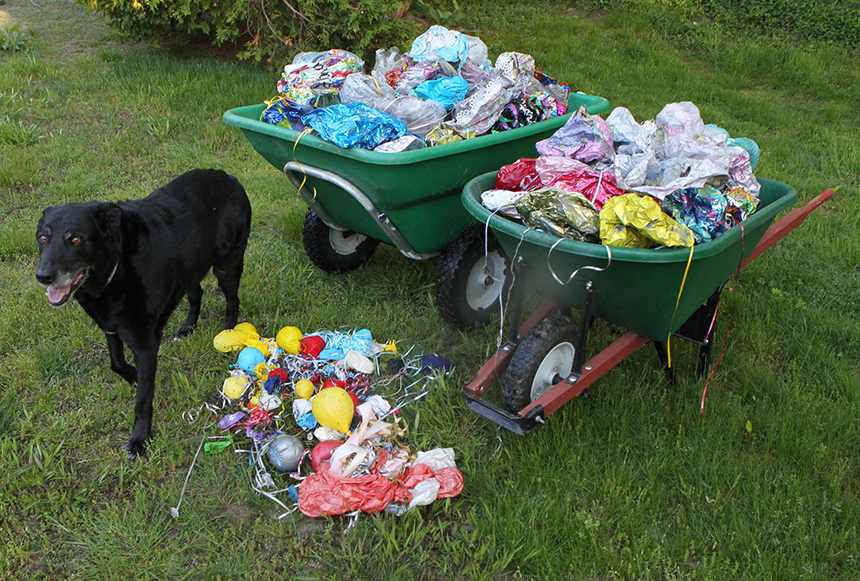By TODD McLEISH/ecoRI News
contributor
 |
| During a single day in May, Little Compton, R.I., resident Geoff Dennis collected 282 balloons on the local beaches he regularly walks. (Courtesy photo) |
But a new study out of Australia provides additional evidence that we should pay much more attention to balloons, because they can have devastating consequences to marine life.
A team of researchers from the
University of Tasmania found that balloons are more deadly when ingested by
seabirds than any other kind of plastic debris.
An examination of 1,733 dead seabirds found that 32 percent had ingested plastic debris, and while soft plastics such as balloons accounted for only 5 percent of the items ingested, they were responsible for 42 percent of the seabird deaths.
An examination of 1,733 dead seabirds found that 32 percent had ingested plastic debris, and while soft plastics such as balloons accounted for only 5 percent of the items ingested, they were responsible for 42 percent of the seabird deaths.
Fragments of balloons composed just 2 percent of all ingested plastic, yet the birds that ingested balloon pieces were 32 times more likely to die than if the bird had ingested a hard plastic like a LEGO brick or lollipop stick.
The researchers said balloons are
especially lethal because they can be easily swallowed and squeeze into a
bird’s stomach cavity.
“A hard piece of plastic has to be the absolute wrong shape and size to block a region in the birds’ gut, whereas soft rubber items can contort to get stuck,” said Lauren Roman, the leader author of the study, in an interview with an Australian news outlet.
Roman believes that seabirds are
attracted to balloons at the surface because their fragments may resemble
squid, which the birds commonly eat. Most of the birds she studied were
shearwaters and petrels, some of which appear in the offshore waters of
southern New England in the summer.
Citing the potential harm to marine
life, the Rhode Island town of New Shoreham (Block Island) banned the sale of
balloons earlier this year.
Many other communities around the country are also taking steps to reduce the release of balloons because of their deadly impact on wildlife.
Clemson University in Georgia ended its tradition of releasing 10,000 balloons before every home football game, for instance, and a campaign in Virginia aims to discourage the release of balloons during wedding celebrations.
Many other communities around the country are also taking steps to reduce the release of balloons because of their deadly impact on wildlife.
Clemson University in Georgia ended its tradition of releasing 10,000 balloons before every home football game, for instance, and a campaign in Virginia aims to discourage the release of balloons during wedding celebrations.
Even The Balloon Council, which represents the
balloon industry, advocates for the responsible handling of balloons, including
never releasing them into the air.
But the release of balloons is still
a significant problem with far-reaching implications, according to local
wildlife rehabilitators and birdwatchers.
Geoff Dennis, a bird photographer
and resident of Little Compton, walks his dog on several local beaches daily
and collects the trash he sees.
One day in late May he collected 282 balloons on the beaches he frequents. He said many more were washing ashore as he arrived. Less than two weeks later, he collected another 99 at the same beaches.
One day in late May he collected 282 balloons on the beaches he frequents. He said many more were washing ashore as he arrived. Less than two weeks later, he collected another 99 at the same beaches.
At a Fourth of July outdoor concert
in Westerly, one birdwatcher in attendance counted 87 balloons released, most
of which probably drifted over the ocean and landed in the water.
“I see them everywhere on the coast,
and the beaches are especially bad,” said Jan St. Jean of Charlestown, an avid
birder who spends much of her time year-round looking for birds along the
coast. “I just think balloons are such a needless thing to purchase.”
And it’s not just the balloons
themselves that are dangerous to birds and other wildlife. The strings attached
to the balloons are a significant entanglement threat that have been
responsible for many animal deaths.
Birdwatcher Becca Thornton of
Carolina wrote on Facebook this month that she rescued a great blue heron that
was entangled in balloon string last year.
“It was completely wrapped around his legs and couldn’t move or open his legs at all,” she wrote. “If I didn't see him, jump in the water and cut the string, he wouldn't be back visiting me this year.”
“It was completely wrapped around his legs and couldn’t move or open his legs at all,” she wrote. “If I didn't see him, jump in the water and cut the string, he wouldn't be back visiting me this year.”
Several other local birders and
wildlife rehabilitators also noted the related concern of birds becoming
entangled in fishing line, which appears to be an ubiquitous problem along the
Rhode Island coast as well.
A bill to ban the release of helium
balloons in Rhode Island, sponsored by Rep. Susan Donovan, D-Bristol, this past
session, would have imposed a $500 fine on violators. The bill was held for
further study by the House Judiciary Committee.
“The problem is that no one away
from the coast sees the balloon problem, only the plastic bag problem,” Dennis
said. “And we know where that bill ended up despite how obvious that problem
is.”